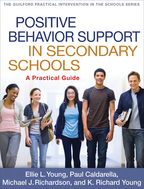Positive Behavior Support in Secondary Schools
A Practical Guide
Ellie L. Young, Paul Caldarella, Michael J. Richardson, and K. Richard Young
A Paperback Originale-bookprint + e-book
A Paperback Original
orderNovember 1, 2011
ISBN 9781609189730
Price: $47.00 158 Pages
Size: 8" x 10½"
This much-needed guide shows how to implement positive behavior support (PBS) strategies in secondary settings, using a three-tiered approach. The authors adapt the core ideas of PBS to the developmental context of adolescence and the organizational structures of middle schools and junior and senior high schools. With an emphasis on data-based decision making, the book provides ideas and examples for meeting the behavioral needs of all students, from those with emerging concerns to those with ongoing, chronic problems. It takes practitioners step by step through planning, implementing, evaluating, and sustaining schoolwide, small-group, and individual interventions. In a convenient large-size format, the book includes useful reproducible forms.
This title is part of The Guilford Practical Intervention in the Schools Series, edited by Sandra M. Chafouleas.
“A well-timed, valuable resource for school staff, principals, and district leaders. This highly readable, straightforward book provides pragmatic, functional guidance for implementing an effective PBS system within a schoolwide model. Attention to the particular challenges of adolescent development and secondary contexts—along with realistic examples of students and schools—are unique strengths of the book. The authors provide a strong rationale for the use of PBS in middle and high schools, explain the work that must be done to set the stage for (and sustain) effective implementation, and describe implementation across all three tiers of response to intervention. This book would be an excellent text for administrative licensure and school psychology programs or for courses on advanced behavior management for teachers.”
—Deanne A. Crone, PhD, Center on Teaching and Learning, University of Oregon
“This book offers exactly what the title promises—a practical guide that is relevant for secondary settings. Readers will increase their understanding of the 'what,' 'why,' and 'how-to' of implementing PBS. The authors describe useful strategies that are grounded in research, emphasizing the critical importance of collaborating with teachers, administrators, and community stakeholders to enhance the school climate.”
—Hank Bohanon, PhD, School of Education, Loyola University Chicago
“As part of the initial research team working to implement these principles in a secondary school setting, I have observed firsthand the dramatic positive correlation to student success and improved school environment. When school personnel model proactive instruction that supports all areas of students’ learning needs, the results are better behaviors and test scores. This book provides specific and tested strategies for success in any educational setting—even with the most difficult students. Ready-to-use forms and questionnaires take school professionals smoothly through the process of creating solution-focused interventions.”
—Brenda Wesson, EdS, Nebo School District, Spanish Fork, Utah
“A comprehensive resource. This well-written, easy-to-read book covers all the essentials for educators in secondary settings to build consensus and implement schoolwide positive behavior supports in their schools. I highly recommend it for building administrators, teachers, school counselors, and school psychologists. This book would be an excellent choice for reading collectively for staff development, especially for a building leadership team.”
—Robert D. Richardson, PhD, evidence-based learning specialist, Canyons School District, Utah
“This is an excellent, comprehensive book for educators dedicated to supporting secondary-age students in the context of three-tiered prevention models. The vignettes throughout the book are engaging and make the context more clear for the reader. Congratulations to the authors for this timely, highly useful resource.”
—Kathleen Lynne Lane, PhD, BCBA-D, Department of Special Education, University of Kansas
Table of Contents
1. Foundational Ideas2. Adolescent Needs and Secondary Settings
3. The Importance of School Climate
4. Planning for Implementation
5. Schoolwide Interventions
6. Monitoring Implementation and Outcomes Using Data
7. Schoolwide Screening
8. Targeted Interventions: Tier 2
9. Individual Interventions: Tier 3
10. Sustainability and Maintenance
About the Authors
Ellie L. Young, PhD, NCSP, is Associate Professor at Brigham Young University, in Provo, Utah, where she is coordinator for the School Psychology Graduate Program. Dr. Young practiced as a school psychologist for 9 years in Kansas and Missouri. Her research focuses on screening in secondary settings and gender issues in education. She maintains a small private practice where she works with youth and their families.Paul Caldarella, PhD, is Director of the Positive Behavior Support Initiative and joint- appointment Associate Professor in the Department of Counseling Psychology and Special Education at Brigham Young University. He served a 1-year internship in child clinical psychology at Arkansas Children’s Hospital and a postdoctoral fellowship in adolescent clinical psychology at Bradley Hospital/Brown University. Dr. Caldarella is both a psychologist and certified school psychologist in the state of Utah. His research interests include assessment and intervention for at-risk youth.
Michael J. Richardson, PhD, is Assistant Professor in the Teacher Education Department at Brigham Young University. He has worked with youth, their parents, and teachers in district youth-in-custody programs, in state youth corrections and family services, and as an in-home family preservation consultant for Utah Youth Village. Dr. Richardson’s teaching and research centers on adolescent development and student and teacher perceptions of behavior problems in schools.
K. Richard Young, PhD, is Dean of the David O. McKay School of Education and Professor in the Department of Counseling Psychology and Special Education at Brigham Young University. Dr. Young has had experience both as a teacher and as a principal in public schools. He is a licensed psychologist and a former professor at Utah State University, where he also codirected the Institute for the Study of Children, Youth and Families at Risk. Dr. Young has published widely on both academic and social topics in education. The prevention and treatment of emotional and behavioral disorders among at-risk children are the primary foci of his research.
